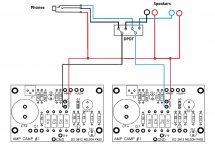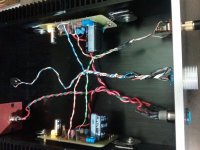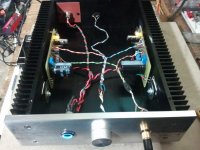Nice, neat and tidy. Can''t quite tell from the photos, but are you using four switching power supplies for the biamped setup? The second to last picture with the white cables looks like something different could have been used.
As I mentioned earlier I considered four Amp Camps with the 200 VA toroid just installed in my build. The modules are small enough to fit all four in one reasonably sized case.
As I mentioned earlier I considered four Amp Camps with the 200 VA toroid just installed in my build. The modules are small enough to fit all four in one reasonably sized case.
Nice, neat and tidy. Can''t quite tell from the photos, but are you using four switching power supplies for the biamped setup? The second to last picture with the white cables looks like something different could have been used.
As I mentioned earlier I considered four Amp Camps with the 200 VA toroid just installed in my build. The modules are small enough to fit all four in one reasonably sized case.
We tried 4 as well as using 2 and splitting between each pair. For me I think the jury was out on the benefits of the extra PSU. The bi-amping was a clear winner though and gave a lot more headroom. With 91db speakers (both small and large) it sounded crystal clear at a healthy listening volume.
Last edited:
Thanks, sounds encouraging. Will get another pair from the next batch and experiment.
zany, "......Separation of instruments and singers was greater, I was made more aware of the surrounding space." That's the same characteristic I thought was so impressive with the larger toriod. Really special for such an uncomplicated design.
zany, "......Separation of instruments and singers was greater, I was made more aware of the surrounding space." That's the same characteristic I thought was so impressive with the larger toriod. Really special for such an uncomplicated design.
Last edited:
Bob, yes, and I am noticing something else... greater sense of timing. On some tracks I'm very familiar with, it seems the ACA has slowed them down as if the rpm dial on a turntable has been turned down... really strange - making me double check that I'm not hallucinating! 

Thanks a lot . I'm glad that you like Italian style
Hahaha, that's why I drive Alfa Romeo, love it!
Beware my Swiss made F5Turbo amp and chassis....I will be posting pictures soon
Maybe I have to apologize for my post#783.
After listening to the ACA #1 being connected to my DIYed desktop - speakers ("Little Susies") for some days now and getting the ACA #1 familiar
with my "Little Susies" and my ears to the sound of the both of them: "both of them are doing a good job".
Best regards - Rudi_Ratlos
After listening to the ACA #1 being connected to my DIYed desktop - speakers ("Little Susies") for some days now and getting the ACA #1 familiar
with my "Little Susies" and my ears to the sound of the both of them: "both of them are doing a good job".
Best regards - Rudi_Ratlos
Last edited:
Rudi this is good to hear.
I too was not impressed with my 2 min trial connected to one set of my speakers (2 way Warfdale's) but there is so much that can go wrong,
like speaker placement - the room is so important also.
I know the SQ is there because with headphones the ACA is 5 times better than all the other amps I have.
It is so much better.
Thanks
I too was not impressed with my 2 min trial connected to one set of my speakers (2 way Warfdale's) but there is so much that can go wrong,
like speaker placement - the room is so important also.
I know the SQ is there because with headphones the ACA is 5 times better than all the other amps I have.
It is so much better.
Thanks
Congo5, Do you have any photos of your setup for the ACAs with earphones? Are you using a balanced set/converter?
I do not have any thing balenced... amps, Sources, or Phones.
Since the ACA is an inverting amp, the outputs marked + are common between channels.
So that becomes headphone common or -
the – out are used for R and L out.
This could be connected to your board or binding posts.
A DPDT Switch between speakers/headphone jack would be nice.
Yes the signal to my phones is inverted but neither my head nor the phones seem to mind.
I hope that is clear ?
yup that looks right.
on the schematic the + outputs are connected to power supply ground so I reversed the colors and
used red for board out -
and black for out +
but colors don't matter as electrons are color blind
your red will still be speaker + on your drawing
on the headphone jack the tip is left channel
on the schematic the + outputs are connected to power supply ground so I reversed the colors and
used red for board out -
and black for out +
but colors don't matter as electrons are color blind
your red will still be speaker + on your drawing
on the headphone jack the tip is left channel
h_fg (heat of vaporization) of water as heat sink
I am new here in this forum so this may be a stupid question. Has anyone considered using the heat of vaporization (h_fg in thermodynamics parlance) of water as a heat sink for hot burning class-A amps? Water is able to remove huge amounts of heat as a substance for heat transfer, it is almost without equal. I am not talking about sensible heat capacity like in a liquid flow heat exchanger but something really simple - a pot of water.
I am considering building the Amp Camp Amp and want to keep this low budget. I can handle the parts from Digikey for $15. What I don't like are the costs of large aluminum heat sinks or fancy enclosures.
I have an old aluminum cookpot that my wife wants to throw away because the non-stick coating is peeling off. I was thinking why not mount the 4 mosfets to the sides, add some water before you start listening, and let the watts start to evaporate the water to cool the transistors? It won't boil because there is not enough heat to overcome the heat of vaporization and radiative losses. But it will get mildly warm. I think a gallon of water will take a long time for those mosfets to cook off.
The heat of vap of water is 540 cal/g or 2257 J/g. Assuming the mosfets dissipate 100 watts or 100 J/sec. This means that you get 23 seconds of run time per gram of water. Let's say you fill the pot with 2 liters of water or 2000 grams before running it. 23 sec/g x 2000 g = 46000 sec or 12.8 hours. Maybe add a thermal shutdown or light timer to turn your SMPS off after 8 hrs in case you forget...
Sure it looks kind of wierd to have your mosfets on a pot of water that can splash. But there are ways around this.
I am new here in this forum so this may be a stupid question. Has anyone considered using the heat of vaporization (h_fg in thermodynamics parlance) of water as a heat sink for hot burning class-A amps? Water is able to remove huge amounts of heat as a substance for heat transfer, it is almost without equal. I am not talking about sensible heat capacity like in a liquid flow heat exchanger but something really simple - a pot of water.
I am considering building the Amp Camp Amp and want to keep this low budget. I can handle the parts from Digikey for $15. What I don't like are the costs of large aluminum heat sinks or fancy enclosures.
I have an old aluminum cookpot that my wife wants to throw away because the non-stick coating is peeling off. I was thinking why not mount the 4 mosfets to the sides, add some water before you start listening, and let the watts start to evaporate the water to cool the transistors? It won't boil because there is not enough heat to overcome the heat of vaporization and radiative losses. But it will get mildly warm. I think a gallon of water will take a long time for those mosfets to cook off.
The heat of vap of water is 540 cal/g or 2257 J/g. Assuming the mosfets dissipate 100 watts or 100 J/sec. This means that you get 23 seconds of run time per gram of water. Let's say you fill the pot with 2 liters of water or 2000 grams before running it. 23 sec/g x 2000 g = 46000 sec or 12.8 hours. Maybe add a thermal shutdown or light timer to turn your SMPS off after 8 hrs in case you forget...
Sure it looks kind of wierd to have your mosfets on a pot of water that can splash. But there are ways around this.
Yup, water's amazing stuff. Your approach should be just fine for most listening sessions.Just that it requires "topping up" which these days people don't want to bother with.
Think about this- when water freezes it floats.... it's less dense.
Normally frozen things aren't .
Lucky, because otherwise frozen water would sink and the oceans would eventually be solid ice.
Think about this- when water freezes it floats.... it's less dense.
Normally frozen things aren't .
Lucky, because otherwise frozen water would sink and the oceans would eventually be solid ice.
- Home
- Amplifiers
- Pass Labs
- Amp Camp Amp - ACA




